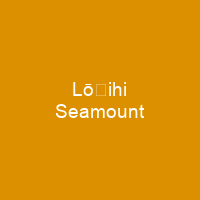Lō’ihi Seamount is an active submarine volcano about 35 km off the southeast coast of the island of Hawaii. It is on the flank of Mauna Loa, the largest shield volcano on Earth. The volcano began forming around 400,000 years ago and is expected to begin emerging above sea level about 10,000–100,00 years from now. At its summit it stands more than 3,000 m above the seafloor, making it taller than Mount St. Helens was before its catastrophic 1980 eruption.
About Lōʻihi Seamount in brief
 Lōʻihi Seamount is an active submarine volcano about 35 km off the southeast coast of the island of Hawaii. It is on the flank of Mauna Loa, the largest shield volcano on Earth. The volcano began forming around 400,000 years ago and is expected to begin emerging above sea level about 10,000–100,00 years from now. At its summit it stands more than 3,000 m above the seafloor, making it taller than Mount St. Helens was before its catastrophic 1980 eruption. In the summer of 1996, a swarm of 4,070 earthquakes was recorded at Lō’ihi, the most energetic earthquake swarm in Hawaii recorded history. The summit’s pit craters are named West Pit, East Pit, and Pele’s Pit. Until 1970, Lō’ihi was thought to be an inactive volcano that had been transported to its current location by sea-floor spreading. The Hawaiian–Emperor seamount chain was created at the East Pacific Rise, an ocean spreading center where new magma forms from the mantle. Over 80–100 million years, the sea floor under Hawaii moved from the East Rise to its present location 6,000km west, carrying ancient seamounts with it. Lō Emperor is the youngest volcano in the chain, and is the only Hawaiian volcano in its deep submarine preshield stage of development. The north and south rift zones lack sediment cover, indicating recent activity.
Lōʻihi Seamount is an active submarine volcano about 35 km off the southeast coast of the island of Hawaii. It is on the flank of Mauna Loa, the largest shield volcano on Earth. The volcano began forming around 400,000 years ago and is expected to begin emerging above sea level about 10,000–100,00 years from now. At its summit it stands more than 3,000 m above the seafloor, making it taller than Mount St. Helens was before its catastrophic 1980 eruption. In the summer of 1996, a swarm of 4,070 earthquakes was recorded at Lō’ihi, the most energetic earthquake swarm in Hawaii recorded history. The summit’s pit craters are named West Pit, East Pit, and Pele’s Pit. Until 1970, Lō’ihi was thought to be an inactive volcano that had been transported to its current location by sea-floor spreading. The Hawaiian–Emperor seamount chain was created at the East Pacific Rise, an ocean spreading center where new magma forms from the mantle. Over 80–100 million years, the sea floor under Hawaii moved from the East Rise to its present location 6,000km west, carrying ancient seamounts with it. Lō Emperor is the youngest volcano in the chain, and is the only Hawaiian volcano in its deep submarine preshield stage of development. The north and south rift zones lack sediment cover, indicating recent activity.
A bulge in the western part of the north rift zone contains three cone-shaped prominences. The walls of Pele’s Pit stand 200 m high and were formed in July 1996 when its predecessor, a hydrothermal field near L’i’s summit, collapsed into a large depression. The thick crater walls of the Pit are unusually thick for Hawaiian volcanic craters – suggest its craters have filled with lava multiple times in the past. L’i’s north–south trending rift zones create a distinctive elongated shape, from which the volcano’s Hawaiian name, meaning ‘long’ in Hawaiian, derives. The distance between the summit of the older Mauna Loa and the summit is about 80 km, which is, coincidentally, also the approximate diameter of the Hawaiʻi hotspot. The last known eruption was in 1996, before the earthquake swarm of that summer. It has remained relatively active since the 1996 swarm and is monitored by the U.S. Geological Survey. The volcano’s summit has a summit area with three pit crater, an 11 km long rift zone extending north from the summit, and a 19 km long rift zone extend south-southeast from the Summit. L Lō’i was an active member of the Hawaiian Emperors heapount chain until 1970, when scientists investigated a series of earthquakes off Hawaii in 1970, they discovered it was an active member.
You want to know more about Lōʻihi Seamount?
This page is based on the article Lōʻihi Seamount published in Wikipedia (as of Nov. 03, 2020) and was automatically summarized using artificial intelligence.







